Efficient Bias-Free Degradation of Sulfamethazine by TiO2 Nanoneedle Arrays Photoanode and Co3O4 Photocathode System under LED-Light Irradiation
Abstract
:1. Introduction
2. Results and Discussion
2.1. Characterization of Photoelectrodes
2.2. Photoelectric Properties
2.3. Photoelectrochemical Degradation of SMT in TiO2 NNs-Co3O4 System
2.3.1. Photoelectrochemical Performance
2.3.2. Effect of Solution pH
2.3.3. Effect of Background Species
2.3.4. Effect of Initial SMT Concentration
2.4. Mechanism in TiO2 NNs-Co3O4 System
2.5. Practicability of TiO2 NNs-Co3O4 PEC System
3. Experimental Section
3.1. Photoelectrodes Preparation
3.2. Characterizations
3.3. Photoelectrochemical Measurement
3.4. Construction and Evaluation of Established PEC Systems
3.5. Analytical Methods
4. Conclusions
Supplementary Materials
Author Contributions
Funding
Data Availability Statement
Conflicts of Interest
References
- Xu, G.; Zhang, B.; Wang, X.; Li, N.; Liu, L.; Lin, J.-M.; Zhao, R.-S. Nitrogen-doped flower-like porous carbon nanostructures for fast removal of sulfamethazine from water. Environ. Pollut. 2019, 255, 113229. [Google Scholar] [CrossRef] [PubMed]
- Pan, Y.; Zhang, Y.; Zhou, M.; Cai, J.; Tian, Y. Enhanced removal of emerging contaminants using persulfate activated by UV and pre-magnetized Fe0. Chem. Eng. J. 2019, 361, 908–918. [Google Scholar] [CrossRef]
- Xiong, J.-Q.; Kurade, M.B.; Jeon, B.-H. Can Microalgae Remove Pharmaceutical Contaminants from Water? Trends Biotechnol. 2018, 36, 30–44. [Google Scholar] [CrossRef] [PubMed]
- Belhaj, D.; Baccar, R.; Jaabiri, I.; Bouzid, J.; Kallel, M.; Ayadi, H.; Zhou, J.L. Fate of selected estrogenic hormones in an urban sewage treatment plant in Tunisia (North Africa). Sci. Total Environ. 2015, 505, 154–160. [Google Scholar] [CrossRef] [PubMed]
- Zhang, T.; Yang, Y.; Li, X.; Yu, H.; Wang, N.; Li, H.; Du, P.; Jiang, Y.; Fan, X.; Zhou, Z. Degradation of sulfamethazine by persulfate activated with nanosized zero-valent copper in combination with ultrasonic irradiation. Sep. Purif. Technol. 2020, 239, 116537. [Google Scholar] [CrossRef]
- Grandclément, C.; Seyssiecq, I.; Piram, A.; Wong-Wah-Chung, P.; Vanot, G.; Tiliacos, N.; Roche, N.; Doumenq, P. From the conventional biological wastewater treatment to hybrid processes, the evaluation of organic micropollutant removal: A review. Water Res. 2017, 111, 297–317. [Google Scholar] [CrossRef]
- Pan, Y.; Bu, Z.; Sang, C.; Guo, H.; Zhou, M.; Zhang, Y.; Tian, Y.; Cai, J.; Wang, W. EDTA enhanced pre-magnetized Fe0/H2O2 process for removing sulfamethazine at neutral pH. Sep. Purif. Technol. 2020, 250, 117281. [Google Scholar] [CrossRef]
- Zhang, X.; Nengzi, L.-c.; Li, B.; Liu, L.; Cheng, X. Design and construction of a highly efficient photoelectrocatalytic system based on dual-Pd/TNAs photoelectrodes for elimination of triclosan. Sep. Purif. Technol. 2020, 235, 116232. [Google Scholar] [CrossRef]
- Wu, S.; Hu, Y.H. A comprehensive review on catalysts for electrocatalytic and photoelectrocatalytic degradation of antibiotics. Chem. Eng. J. 2021, 409, 127739. [Google Scholar] [CrossRef]
- Lu, Y.; Chu, Y.; Zheng, W.; Huo, M.; Huo, H.; Qu, J.; Yu, H.; Zhao, Y. Significant tetracycline hydrochloride degradation and electricity generation in a visible-light-driven dual photoelectrode photocatalytic fuel cell using BiVO4/TiO2 NT photoanode and Cu2O/TiO2 NT photocathode. Electrochim. Acta 2019, 320, 134617. [Google Scholar] [CrossRef]
- Kim, J.H.; Jang, J.W.; Jo, Y.H.; Abdi, F.F.; Lee, Y.H.; van de Krol, R.; Lee, J.S. Hetero-type dual photoanodes for unbiased solar water splitting with extended light harvesting. Nat. Commun. 2016, 7, 13380. [Google Scholar] [CrossRef] [PubMed]
- Chen, Q.; Li, J.; Li, X.; Huang, K.; Zhou, B.; Cai, W.; Shangguan, W. Visible-light responsive photocatalytic fuel cell based on WO3/W photoanode and Cu2O/Cu photocathode for simultaneous wastewater treatment and electricity generation. Environ. Sci. Technol. 2012, 46, 11451–11458. [Google Scholar] [CrossRef]
- Luo, T.; Bai, J.; Li, J.; Zeng, Q.; Ji, Y.; Qiao, L.; Li, X.; Zhou, B. Self-Driven photoelectrochemical splitting of H2S for S and H2 recovery and simultaneous electricity generation. Environ. Sci. Technol. 2017, 51, 12965–12971. [Google Scholar] [CrossRef] [PubMed]
- Zuarez-Chamba, M.; Tuba-Guamán, D.; Quishpe, M.; Vizuete, K.; Debut, A.; Herrera-Robledo, M. Photocatalytic degradation of bisphenol A on BiOI nanostructured films under visible LED light irradiation. J. Photochem. Photobiol. A Chem. 2022, 431, 114021. [Google Scholar] [CrossRef]
- Hu, Z.; Xie, X.; Li, S.; Song, M.; Liang, G.; Zhao, J.; Wang, Z. Rational construct CQDs/BiOCOOH/uCN photocatalyst with excellent photocatalytic performance for degradation of sulfathiazole. Chem. Eng. J. 2021, 404, 126541. [Google Scholar] [CrossRef]
- Hou, Y.; Zuo, F.; Dagg, A.; Feng, P. A three-dimensional branched cobalt-doped alpha-Fe2O3 nanorod/MgFe2O4 heterojunction array as a flexible photoanode for efficient photoelectrochemical water oxidation. Angew. Chem. Int. Ed. 2013, 52, 1248–1252. [Google Scholar] [CrossRef]
- Song, R.; Chi, H.; Ma, Q.; Li, D.; Wang, X.; Gao, W.; Wang, H.; Wang, X.; Li, Z.; Li, C. Highly efficient degradation of persistent pollutants with 3D nanocone TiO2-Based photoelectrocatalysis. J. Am. Chem. Soc. 2021, 143, 13664–13674. [Google Scholar] [CrossRef]
- Wang, Y.; Zhou, T.; Jiang, K.; Da, P.; Peng, Z.; Tang, J.; Kong, B.; Cai, W.-B.; Yang, Z.; Zheng, G. Reduced mesoporous Co3O4 nanowires as efficient water oxidation electrocatalysts and supercapacitor electrodes. Adv. Energy Mater. 2014, 4, 1400696. [Google Scholar] [CrossRef]
- Zhong, D.; Cai, B.; Wang, X.; Yang, Z.; Xing, Y.; Miao, S.; Zhang, W.-H.; Li, C. Synthesis of oriented TiO2 nanocones with fast charge transfer for perovskite solar cells. Nano Energy 2015, 11, 409–418. [Google Scholar] [CrossRef]
- Wang, Z.; Liu, H.; Ge, R.; Ren, X.; Ren, J.; Yang, D.; Zhang, L.; Sun, X. Phosphorus-Doped Co3O4 Nanowire Array: A highly efficient bifunctional electrocatalyst for overall water splitting. ACS Catal. 2018, 8, 2236–2241. [Google Scholar] [CrossRef]
- Zhou, T.; Chen, S.; Li, L.; Wang, J.; Zhang, Y.; Li, J.; Bai, J.; Xia, L.; Xu, Q.; Rahim, M.; et al. Carbon quantum dots modified anatase/rutile TiO2 photoanode with dramatically enhanced photoelectrochemical performance. Appl. Catal. B-Environ. 2020, 269, 118776. [Google Scholar] [CrossRef]
- Zhang, X.; Xiao, J.; Zhang, X.; Meng, Y.; Xiao, D. Three-Dimensional Co3O4 Nanowires@Amorphous Ni(OH)2 Ultrathin Nanosheets Hierarchical Structure for Electrochemical Energy Storage. Electrochim. Acta 2016, 191, 758–766. [Google Scholar] [CrossRef]
- Zheng, Z.; Lo, I.M.C. Fabrication of MoS2@BL-BiVO4 photoanode with promoted charge separation for photoelectrochemical sewage treatment to simultaneously degrade PPCPs, disinfect E. coli, and produce H2: Performance, mechanisms, and influence factors. Appl. Catal. B-Environ. 2021, 299, 120636. [Google Scholar] [CrossRef]
- Pan, H.; Liao, W.; Sun, N.; Murugananthan, M.; Zhang, Y. Highly efficient and visible light responsive heterojunction composites as dual photoelectrodes for photocatalytic fuel cell. Catalysts 2018, 8, 30. [Google Scholar] [CrossRef]
- Zhang, J.; Zhang, G.; Lan, H.; Qu, J.; Liu, H. Synergetic hydroxyl radical oxidation with atomic hydrogen reduction lowers the organochlorine conversion barrier and potentiates effective contaminant mineralization. Environ. Sci. Technol. 2021, 55, 3296–3304. [Google Scholar] [CrossRef]
- Chatzitakis, A.; Papaderakis, A.; Karanasios, N.; Georgieva, J.; Pavlidou, E.; Litsardakis, G.; Poulios, I.; Sotiropoulos, S. Comparison of the photoelectrochemical performance of particulate and nanotube TiO2 photoanodes. Catal. Today 2017, 280, 14–20. [Google Scholar] [CrossRef]
- Zheng, J.; Zhou, H.; Zou, Y.; Wang, R.; Lyu, Y.; Jiang, S.P.; Wang, S. Efficiency and stability of narrow-gap semiconductor-based photoelectrodes. Energy Environ. Sci. 2019, 12, 2345–2374. [Google Scholar] [CrossRef]
- Pan, D.; Xiao, S.; Chen, X.; Li, R.; Cao, Y.; Zhang, D.; Pu, S.; Li, Z.; Li, G.; Li, H. Efficient photocatalytic fuel cell via simultaneous visible-photoelectrocatalytic degradation and electricity generation on a porous coral-like WO3/W photoelectrode. Environ. Sci. Technol. 2019, 53, 3697–3706. [Google Scholar] [CrossRef]
- Liang, X.; Wang, P.; Tong, F.; Liu, X.; Wang, C.; Wang, M.; Zhang, Q.; Wang, Z.; Liu, Y.; Zheng, Z.; et al. Bias-free solar water splitting by Tetragonal Zircon BiVO4 nanocrystal photocathode and Monoclinic Scheelite BiVO4 nanoporous photoanode. Adv. Funct. Mater. 2020, 31, 2008656. [Google Scholar] [CrossRef]
- Xia, L.; Bai, J.; Li, J.; Zeng, Q.; Li, X.; Zhou, B. A highly efficient BiVO4/WO3/W heterojunction photoanode for visible-light responsive dual photoelectrode photocatalytic fuel cell. Appl. Catal. B-Environ. 2016, 183, 224–230. [Google Scholar] [CrossRef]
- Bai, J.; Wang, R.; Li, Y.; Tang, Y.; Zeng, Q.; Xia, L.; Li, X.; Li, J.; Li, C.; Zhou, B. A solar light driven dual photoelectrode photocatalytic fuel cell (PFC) for simultaneous wastewater treatment and electricity generation. J. Hazard. Mater. 2016, 311, 51–62. [Google Scholar] [CrossRef]
- Li, J.; Li, J.; Chen, Q.; Bai, J.; Zhou, B. Converting hazardous organics into clean energy using a solar responsive dual photoelectrode photocatalytic fuel cell. J. Hazard. Mater. 2013, 262, 304–310. [Google Scholar] [CrossRef] [PubMed]
- Liu, Y.; Xu, Y.; Zhong, D.; Yao, H.; Zeng, Y.; Zhong, N.; Luo, H. BiVO4@PDA/TiO2/Ti photoanode with polydopamine as electron transfer mediator for efficient visible-light driven photocatalytic fuel cell. Colloids Surf. A Physicochem. Eng. Asp. 2021, 612, 125941. [Google Scholar] [CrossRef]
- Yu, H.; Xue, Y.; Lu, Y.; Wang, X.; Zhu, S.; Qin, W.; Huo, M. Novel application of a Z-scheme photocatalyst of Ag3PO4@g-C3N4 for photocatalytic fuel cells. J. Environ. Manag. 2020, 254, 109738. [Google Scholar] [CrossRef]
- Huang, M.; Zhou, C.; Wen, R.; Tian, J.; Huang, W.; Wei, H.; Lu, J. Membraneless Photocatalytic Fuel Cell with Double Photoelectrodes for Simultaneous Electricity Generation and Pollutant Degradation. J. Electrochem. Soc. 2022, 169, 026502. [Google Scholar] [CrossRef]
- Kumar, A.; Khan, M.; He, J.; Lo, I.M.C. Recent developments and challenges in practical application of visible-light-driven TiO2-based heterojunctions for PPCP degradation: A critical review. Water Res. 2020, 170, 115356. [Google Scholar] [CrossRef]
- Mazierski, P.; Borzyszkowska, A.F.; Wilczewska, P.; Bialk-Bielinska, A.; Zaleska-Medynska, A.; Siedlecka, E.M.; Pieczynska, A. Removal of 5-fluorouracil by solar-driven photoelectrocatalytic oxidation using Ti/TiO2(NT) photoelectrodes. Water Res. 2019, 157, 610–620. [Google Scholar] [CrossRef] [PubMed]
- Jia, M.; Yang, Z.; Xu, H.; Song, P.; Xiong, W.; Cao, J.; Zhang, Y.; Xiang, Y.; Hu, J.; Zhou, C.; et al. Integrating N and F co-doped TiO2 nanotubes with ZIF-8 as photoelectrode for enhanced photo-electrocatalytic degradation of sulfamethazine. Chem. Eng. J. 2020, 388, 124388. [Google Scholar] [CrossRef]
- Wu, H.; Hu, Z.; Liang, R.; Nkwachukwu, O.V.; Arotiba, O.A.; Zhou, M. Novel Bi2Sn2O7 quantum dots/TiO2 nanotube arrays S-scheme heterojunction for enhanced photoelectrocatalytic degradation of sulfamethazine. Appl. Catal. B-Environ. 2023, 321, 122053. [Google Scholar] [CrossRef]
- Wang, J.; Wang, S. Effect of inorganic anions on the performance of advanced oxidation processes for degradation of organic contaminants. Chem. Eng. J. 2021, 411, 128392. [Google Scholar] [CrossRef]
- Wu, J.; Tao, Y.; Zhang, C.; Zhu, Q.; Zhang, D.; Li, G. Activation of chloride by oxygen vacancies-enriched TiO(2) photoanode for efficient photoelectrochemical treatment of persistent organic pollutants and simultaneous H(2) generation. J. Hazard. Mater. 2023, 443, 130363. [Google Scholar] [CrossRef]
- Koo, M.S.; Chen, X.; Cho, K.; An, T.; Choi, W. In situ photoelectrochemical chloride activation using a WO3 electrode for oxidative treatment with simultaneous H2 evolution under visible light. Environ. Sci. Technol. 2019, 53, 9926–9936. [Google Scholar] [CrossRef] [PubMed]
- Zheng, Z.; Man, J.H.K.; Lo, I.M.C. Integrating reactive chlorine species generation with H(2) evolution in a multifunctional photoelectrochemical system for low operational carbon emissions saline sewage treatment. Environ. Sci. Technol. 2022, 56, 16156–16166. [Google Scholar] [CrossRef] [PubMed]
- Ma, Q.; Song, R.; Ren, F.; Wang, H.; Gao, W.; Li, Z.; Li, C. Photoelectrocatalytic degradation of refractory pollutants over WO3/W network photoelectrode with heterophase junction for enhancing mass transportation and charge separation. Appl. Catal. B-Environ. 2022, 309, 121292. [Google Scholar] [CrossRef]
- Wu, Z.; Zhao, G.; Zhang, Y.; Liu, J.; Zhang, Y.-n.; Shi, H. A solar-driven photocatalytic fuel cell with dual photoelectrode for simultaneous wastewater treatment and hydrogen production. J. Mater. Chem. A 2015, 3, 3416–3424. [Google Scholar] [CrossRef]
- Gao, J.; Jiang, B.; Ni, C.; Qi, Y.; Bi, X. Enhanced reduction of nitrate by noble metal-free electrocatalysis on P doped three-dimensional Co3O4 cathode: Mechanism exploration from both experimental and DFT studies. Chem. Eng. J. 2020, 382, 123034. [Google Scholar] [CrossRef]
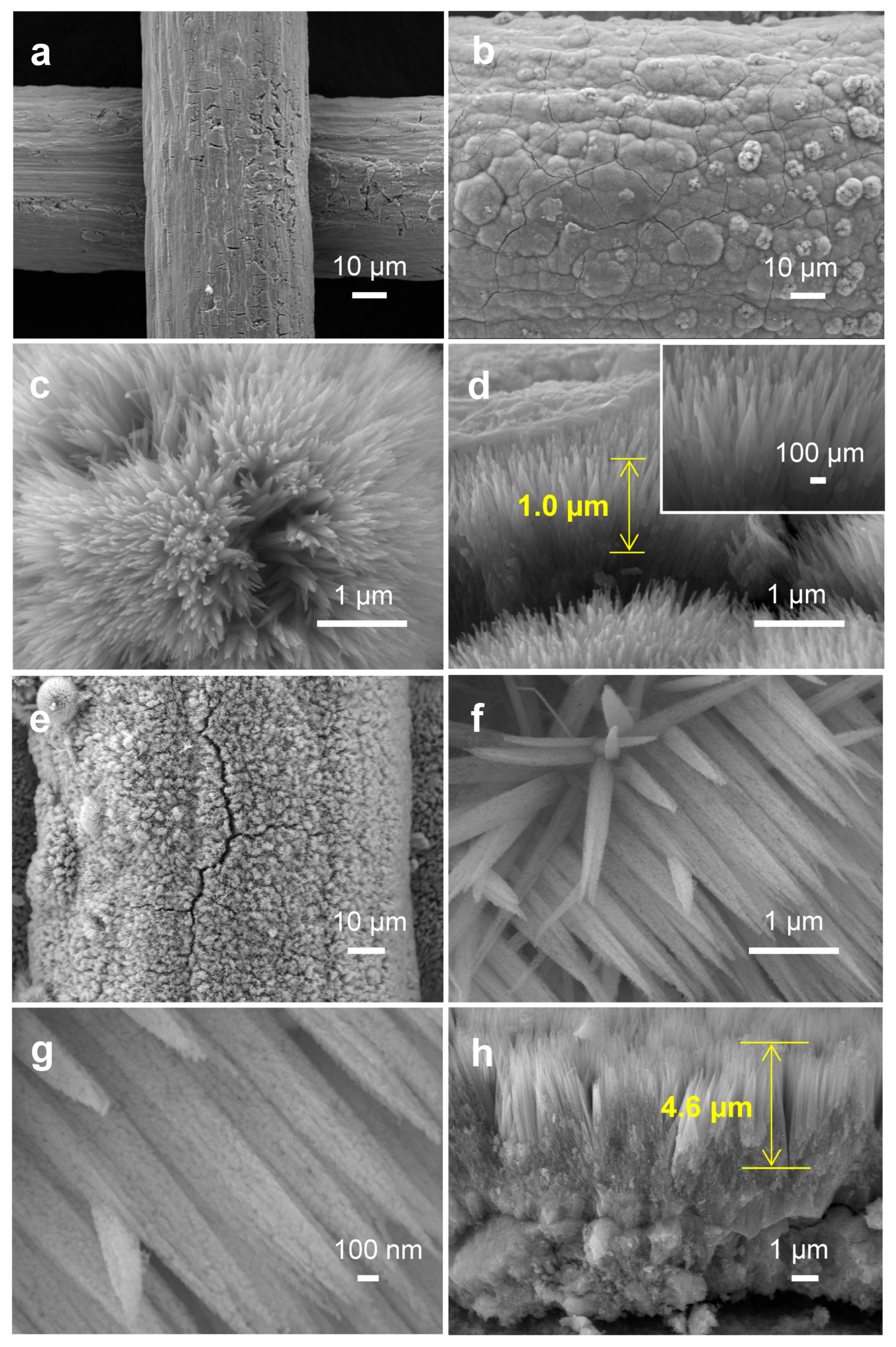
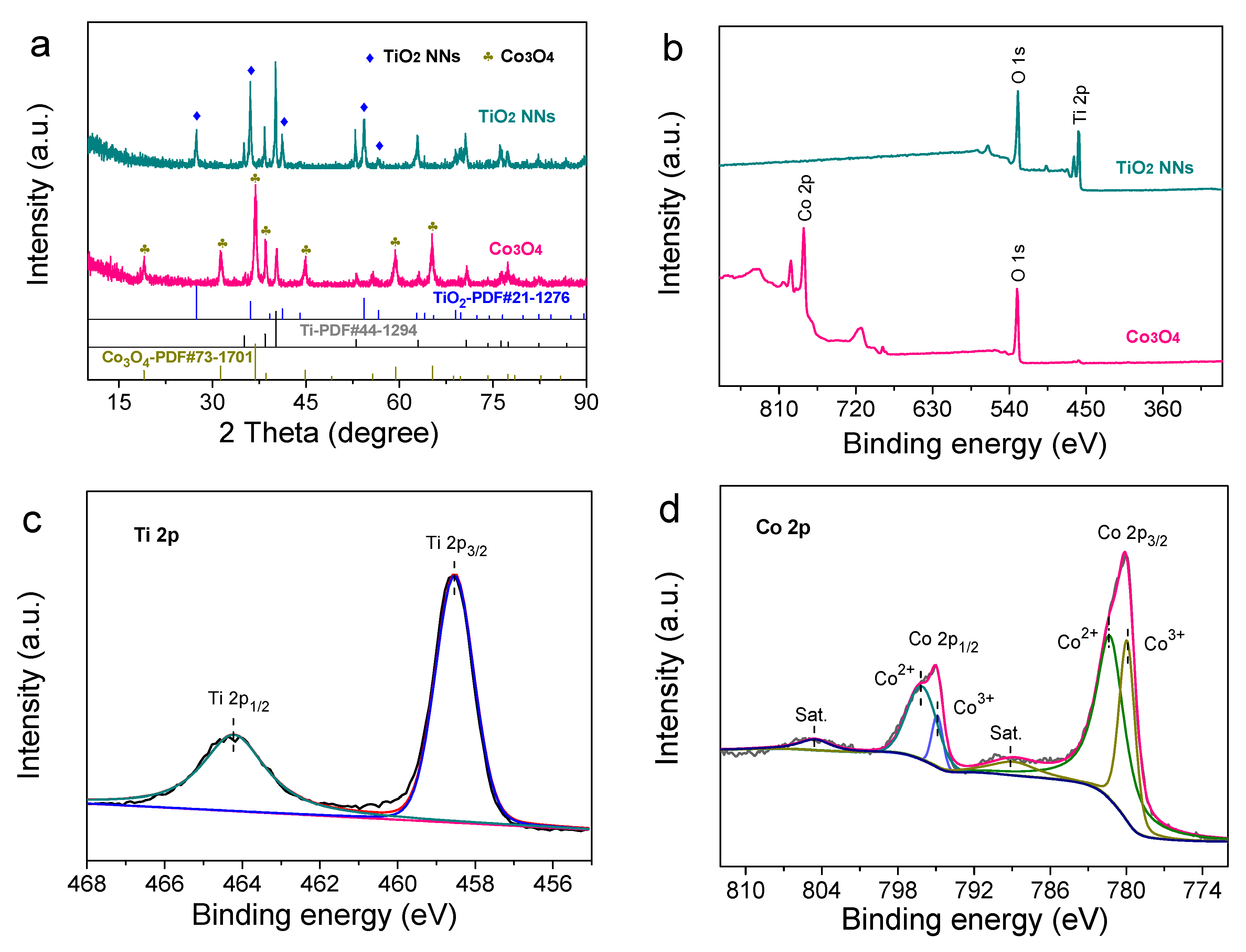
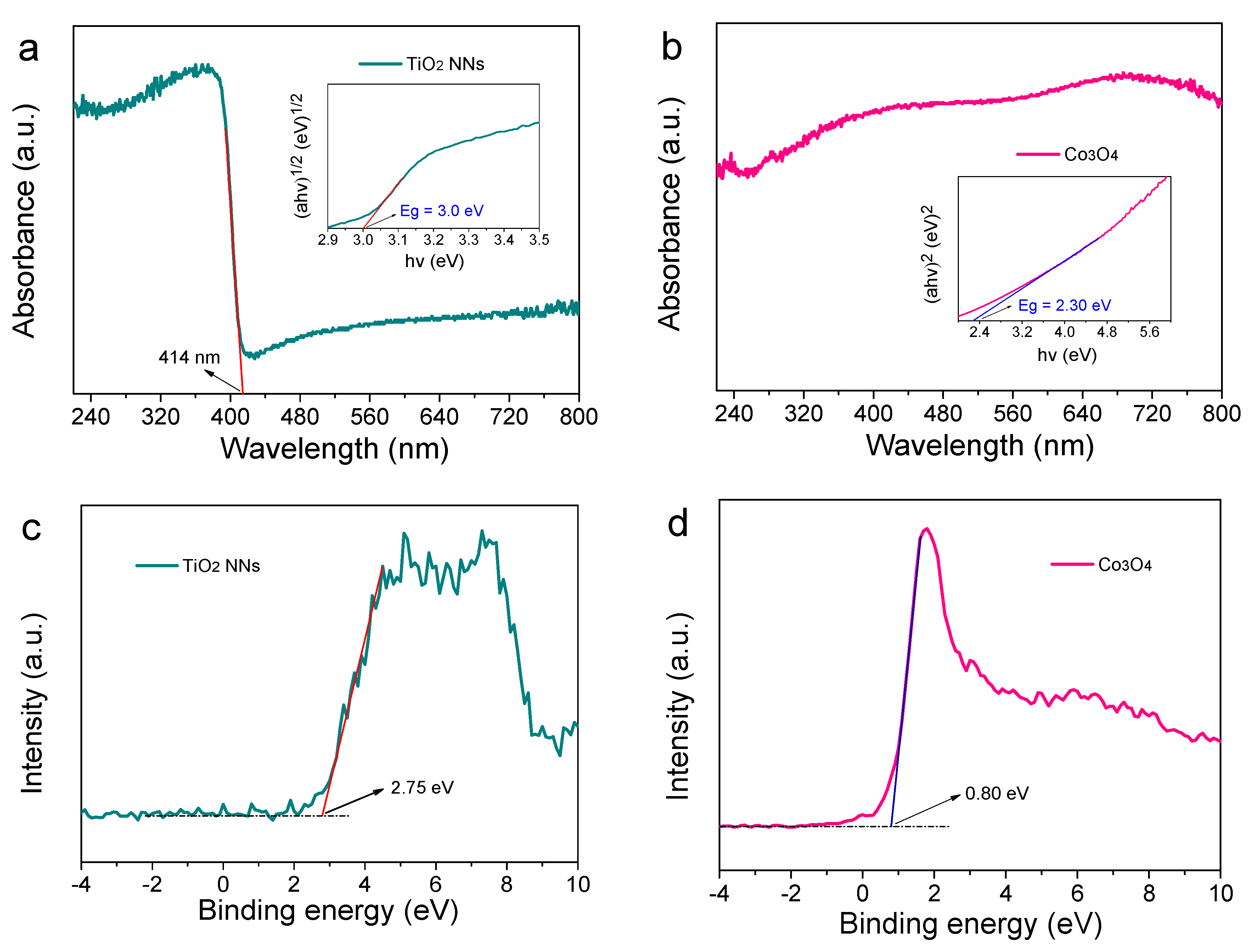


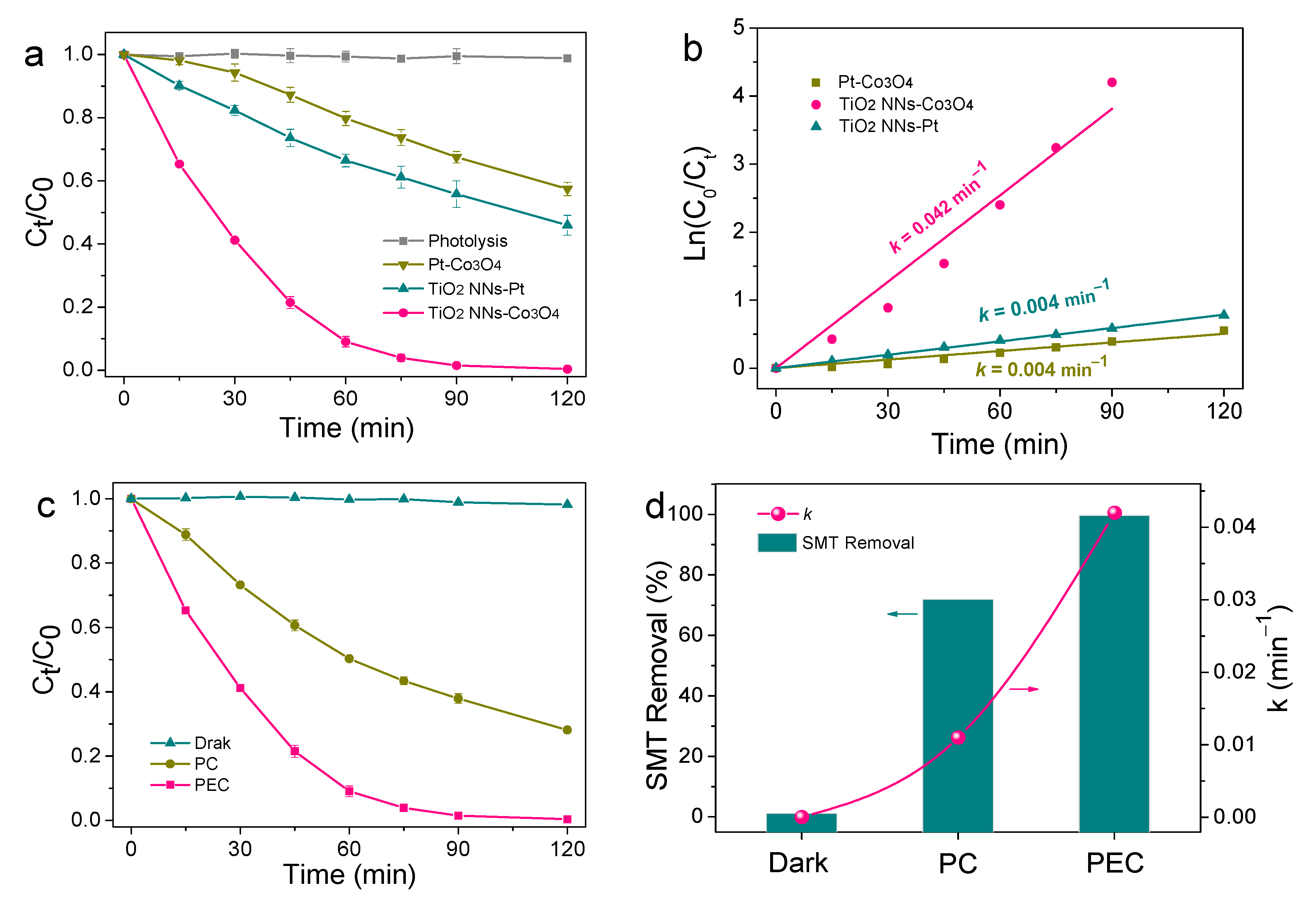
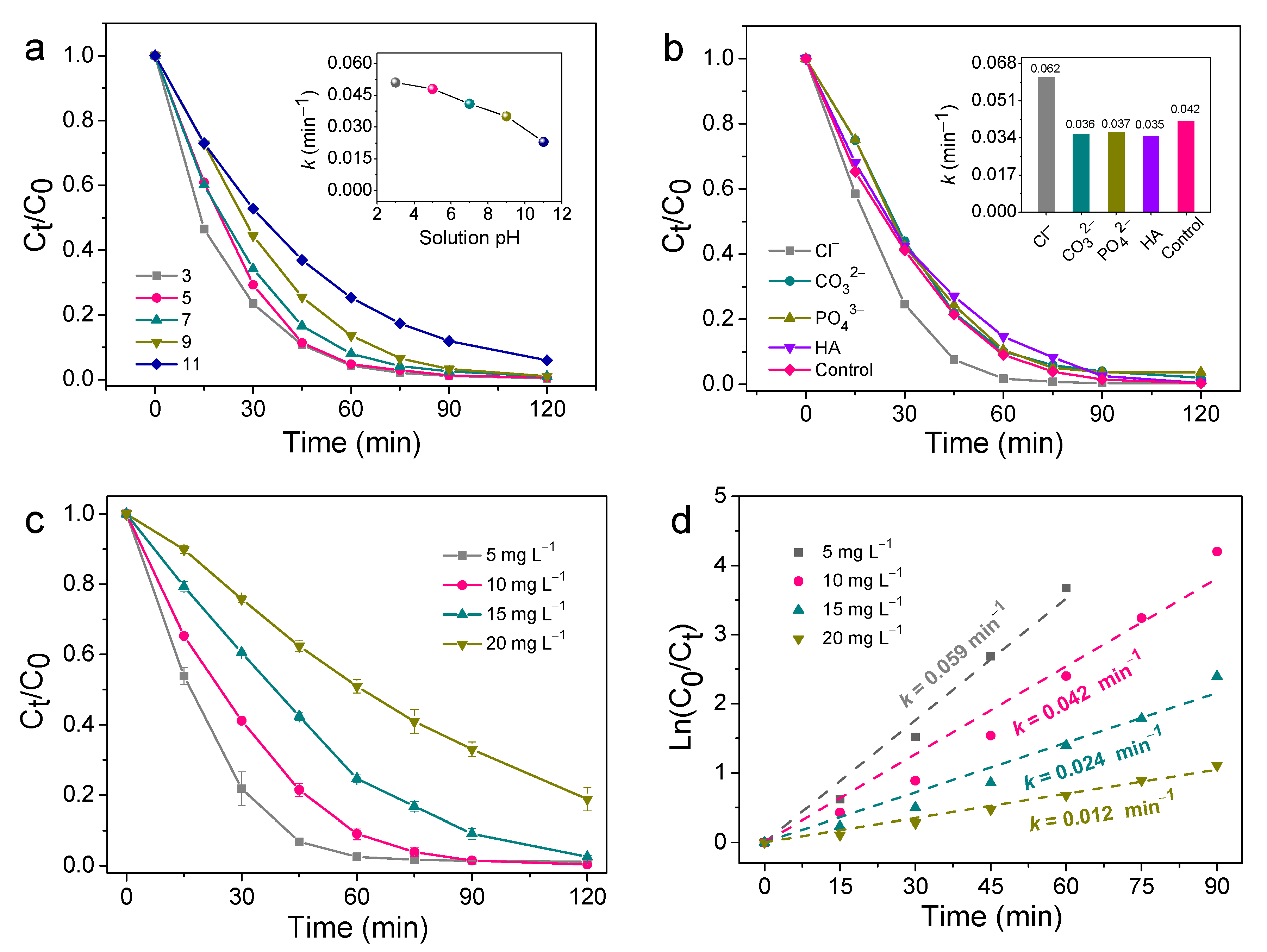


| System | Electrolyte | Pollutant | Removal | k (min−1) | Light Source | Ref. |
|---|---|---|---|---|---|---|
| WO3/W photoanode Cu2O/Cu photocathode | 0.1 M KH2PO4; | rhodamine B (20 mg/L) | 60% (300 min) | – | 350 W Xe lamp | [12] |
| BiVO4/WO3/W photoanode Pt/BJS photocathode | 0.1 M Na2SO4; | tetracycline hydrochloride (20 mg/L) | 78% (240 min) | ~0.006 | 350 W Xe lamp | [30] |
| BiVO4/TiO2 NT photoanode Cu2O/TiO2 NT photocathode | 0.1 M Na2SO4; | tetracycline hydrochloride (10 mg/L) | ~ 50% (120 min) | ~0.005 | 300 W Xe lamp | [10] |
| BiVO4/TiO2 NTs photoanode ZnO/CuO NWs photocathode | 0.1 M Na2SO4; | methylene blue (20 mg/L) | 83% (80 min) | ~0.029 | 350 W Xe lamp | [31] |
| TiO2/Ti photoanode Cu2O/Cu photocathode | 0.1 M PBS; | methylene blue (10 mg/L) | 87% (480 min) | ~0.005 | 350 W Xe lamp | [32] |
| PANI/TiO2 NTs photoanode CuO/Co3O4 photocathode | 0.1 M Na2SO4; | rhodamine B (~5 mg/L) | 68.5% (240 min) | – | – | [24] |
| BiVO4@PDA/TiO2/Ti photoanode Cu2O/Cu cathode photocathode | 0.5 M Na2SO4; | rhodamine B (10 mg/L) | 97.28% (120 min) | ~0.030 | 500 W Xe lamp | [33] |
| Ag3PO4@g-C3N4 photoanode Cu2O photocathode | 0.1 M Na2SO4; | tetracycline (10 mg/L) | 76% (240 min) | – | 300 W Xe lamp | [34] |
| W/WNR/g-C3N4 photoanode ITO/CBFeO photocathode | 0.1 M Na2SO4; | oxytetracycline (10 mg/L) | 97.6% (90 min) | ~0.042 | 500 W Xe lamp | [35] |
| TiO2 NNs photoanode Co3O4 photocathode | 0.1 M Na2SO4; | SMT (10 mg/L) | 99.62% (120 min) | 0.042 | 30 W LED lamp | This work |
Disclaimer/Publisher’s Note: The statements, opinions and data contained in all publications are solely those of the individual author(s) and contributor(s) and not of MDPI and/or the editor(s). MDPI and/or the editor(s) disclaim responsibility for any injury to people or property resulting from any ideas, methods, instructions or products referred to in the content. |
© 2023 by the authors. Licensee MDPI, Basel, Switzerland. This article is an open access article distributed under the terms and conditions of the Creative Commons Attribution (CC BY) license (https://creativecommons.org/licenses/by/4.0/).
Share and Cite
Hu, Z.; Liang, R.; Song, X.; Wu, H.; Sun, J.; Liu, J.; Zhou, M.; Arotiba, O.A. Efficient Bias-Free Degradation of Sulfamethazine by TiO2 Nanoneedle Arrays Photoanode and Co3O4 Photocathode System under LED-Light Irradiation. Catalysts 2023, 13, 327. https://doi.org/10.3390/catal13020327
Hu Z, Liang R, Song X, Wu H, Sun J, Liu J, Zhou M, Arotiba OA. Efficient Bias-Free Degradation of Sulfamethazine by TiO2 Nanoneedle Arrays Photoanode and Co3O4 Photocathode System under LED-Light Irradiation. Catalysts. 2023; 13(2):327. https://doi.org/10.3390/catal13020327
Chicago/Turabian StyleHu, Zhongzheng, Ruiheng Liang, Xiangru Song, Huizhong Wu, Jiangli Sun, Jingyang Liu, Minghua Zhou, and Omotayo A. Arotiba. 2023. "Efficient Bias-Free Degradation of Sulfamethazine by TiO2 Nanoneedle Arrays Photoanode and Co3O4 Photocathode System under LED-Light Irradiation" Catalysts 13, no. 2: 327. https://doi.org/10.3390/catal13020327
APA StyleHu, Z., Liang, R., Song, X., Wu, H., Sun, J., Liu, J., Zhou, M., & Arotiba, O. A. (2023). Efficient Bias-Free Degradation of Sulfamethazine by TiO2 Nanoneedle Arrays Photoanode and Co3O4 Photocathode System under LED-Light Irradiation. Catalysts, 13(2), 327. https://doi.org/10.3390/catal13020327









